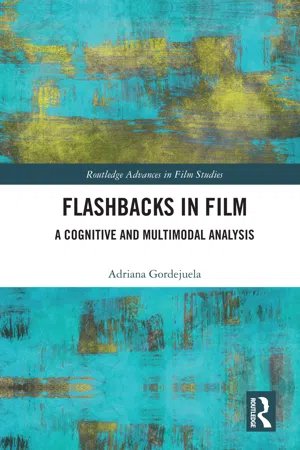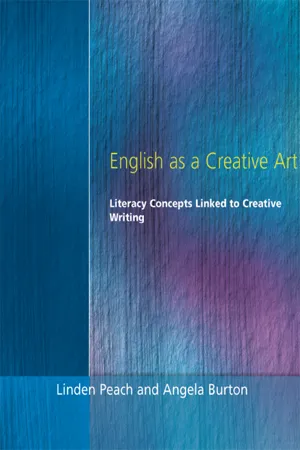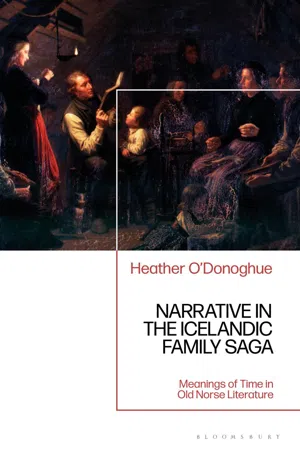Literature
Analepsis
Analepsis, also known as flashback, is a literary technique where the narrative shifts to an earlier point in time to provide background information or context for the story. It allows the reader to gain a deeper understanding of the characters and events by presenting past events within the current narrative. Analepsis is a powerful tool for adding depth and complexity to storytelling.
Written by Perlego with AI-assistance
3 Key excerpts on "Analepsis"
- eBook - ePub
Flashbacks in Film
A Cognitive and Multimodal Analysis
- Adriana Gordejuela(Author)
- 2021(Publication Date)
- Routledge(Publisher)
Analepsis is “[a] literary device in narrative, in which a past event is narrated at a point later than its chronological place in a story”.1 The original definition is in French: “[T]oute évocation après coup d’un événement antérieur au point de l’histoire où l’on se trouve”. The translation is mine.Maureen Turim, in an extended study of film flashbacks (the most comprehensive to date), offers a similar definition of the cinematic device: “a flashback is simply an image or a filmic segment that is understood as representing temporal occurrences anterior to those in the images that preceded it” (Turim, 1989, p. 1). But, beyond the explanation of the term (which, in fact, matches the classical concept of Analepsis), what is really interesting about Turim’s contribution is her review of the etymology of the term flashback. Around the turn of the 20th century, the word flash was used to refer not only to a brief burst of light but also to talk about explosions and the ignition of engines as well as to refer to a particular kind of glance. And so, Turim argues (1989, p. 3), “[t]his combination of brief instances of light, of explosive power, and of the change in direction and quality of a glance are appropriate antecedents to the term flashback in its cinematic sense”. These specific meanings of the form flash may be the reason why film preferred the term flashback over Analepsis, since in some way it refers to the speed with which film editing introduces temporal and spatial leaps to the past in the story. Later on, when the term flashback was consolidated in the cinematic field, it started to be used in literary studies as well, as a synonym for Analepsis (Turim, 1989, p. 4). The current definition of flashback in the OED (Flashback, n.d.) reflects this expansion in the use of the term: a flashback is “[a] scene in a film, novel, etc. set in a time earlier than the main story”. However, even though the cinematographic origin of the word is not usually mentioned, and although film flashbacks do not normally take the form of mental flashes (as will be discussed later, they are often introduced by marked transitions and in a slow and smooth way), the term flashback - eBook - ePub
English as a Creative Art
Literacy Concepts Linked to Creative Writing
- Linden Peach, Angela Burton(Authors)
- 2018(Publication Date)
- David Fulton Publishers(Publisher)
The narrative literally returns to an earlier event. An Analepsis may provide additional information about an event occurring or a character involved at the point of the narrative when the Analepsis is introduced. However, more unusually, it may provide information about events and characters from another part of the narrative. A prolepsis is the narration of an event at a point in the narrative before earlier events have been narrated. However, the process of foreshadowing can be subtler than this. An example of a prolepsis occurs, for example, at the beginning of Nathaniel Hawthorne’s The Blithedale Romance, a nineteenth-century American novel in which Zenobia’s death, which ends the promise of her young life is anticipated by the way a cold wind kills the spring buds. The cold wind, then, is an example of prolepsis. Foreshadowing is a more common form of prolepsis than the actual narration of an event ‘from the future’. We normally read a narrative in order to discover what will happen next. A prolepsis changes our motivation in reading to ‘how did it happen?’ In the film Woman in Red we know that the main character is going to end up on a window ledge. The whole film is about how he got there. In a sense the prolepsis turns most of the film into an Analepsis. The prolepsis narrates a future for the viewer which is a past for the main character. In literature, narratives which involve prolepsis are normally first person narratives - eBook - ePub
Narrative in the Icelandic Family Saga
Meanings of Time in Old Norse Literature
- Heather O'Donoghue(Author)
- 2021(Publication Date)
- Bloomsbury Academic(Publisher)
In conclusion, I want to look at some less successful examples of anachrony in saga narrative. As we have seen in the course of this chapter, prolepsis can produce a grim sense of foreboding, can induce suspense, and can allow both audience and characters to imagine the future in the context of the narrative present, whether or not it actually influences the behaviour of those characters, or even whether or not what is predicted actually comes to pass. It also reinforces our sense of the passed past producing a predestined future for those living through the narrative present, and we as audience situate ourselves in a time outside the third time of narrative, looking down, or back, on it. Analepsis can also allow us and the characters to see the narrative past in the context of the narrative present, and to compare two versions of events. Displacing both Analepsis and prolepsis on to the characters also adds to our understanding of their natures and dispositions. But the crucial difference between the two is that prolepsis in narrative is always a proactive and considered strategy – it doesn’t come about by accident. The risk with Analepsis is that it can be hard to distinguish Analepsis for literary effect from simple authorial oversight: something the narrator should have revealed earlier, or more clearly.This is easier to illustrate than to describe. In Laxdœla saga, when Óláfr pái travels to Ireland to meet his royal grandfather, his mother Melkorka gives him a ‘fingrgull mikit’ (large gold ring) which she describes as having been given to her by her father as a teething gift.173 In Ireland, that ring plays a major part in identifying Óláfr as the genuine grandson of Mýrkjartan. As a token of identity, it resembles a common enough trope in folklore and romance literature, for instance.174 And yet it is not at all plausible that Melkorka could have kept possession of the ring all through her abduction and slavery. When Höskuldr buys her, she is destitute, and poorly dressed. If the saga author produces the token analeptically, just in time for Óláfr’s trip to Ireland to seek out his roots, some explanation of how Melkorka managed to keep it hidden is necessary for the Analepsis to be convincing.In Njáls saga, in another implausible Analepsis, Gunnarr acts out Njáll’s plan for him to reclaim his kinswoman Unnr’s dowry from her ex-husband Hrútr, involving disguising himself as a pedlar, as I discussed earlier in this chapter. Afterwards, when the household is asleep, Gunnarr and his men sneak out of Hrútr’s farmhouse and ride away. But the same night, Hrútr’s half-brother Höskuldr dreams that Hrútr’s farm was visited by a bear, and this leads him to suspect a trick. He questions his household about a tall man they had seen earlier in the day. One of them replies, ‘Þat sá ek, at fram undan erminni kom eitt gullhlað ok rautt klæði; á hœgri hendi hafði hann gullhring’ (I saw that [coming] out from under his sleeve there was gold decoration, and red cloth; and on his right hand he wore a gold ring).175 Höskuldr immediately realizes that his dream of a bear was a vision of Gunnarr’s fylgja
Index pages curate the most relevant extracts from our library of academic textbooks. They’ve been created using an in-house natural language model (NLM), each adding context and meaning to key research topics.


